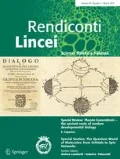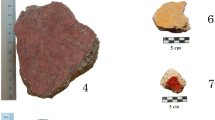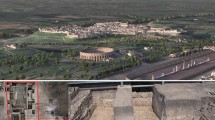Abstract
The reconstruction of Roman decorative apparatus from delocalized fragments is an arduous challenge for the archaeologists. An archaeometric approach may integrate the archaeological analyses, based on the stylistic observations, improving the ability to merge adjacent fragments, especially in the absence of distinctive ornamental elements. In this work, the capacity of reflection FT-IR spectroscopy combined with chemometric tools to identify groups of fragments that have similar chemical composition of the pictorial layers is tested. Synchrotron radiation-based Fourier transform infrared (SR-FTIR) microspectroscopy coupled with scanning electron microscopy (SEM) and energy-dispersive X-ray micro-analysis (EDX) performed on cross section were used to enhance the performance of conventional FT-IR technique and to localize micrometric-size compounds. The chemometric approach proposed in this work turns out to be a powerful way to discriminate pictorial layers with similar chemical composition, by the identification of different compounds. The use of SR source has permitted to improve the lateral resolution and to discriminate neighboring micro-compounds, such as quartz and cuprorivaite in Egyptian blue pigments.







Similar content being viewed by others
References
Aliatis I, Bersani D, Campani E, Casoli A, Lottici PP, Mantovan S, Marino IG (2010) Pigments used in Roman wall paintings in the Vesuvian area. J Raman Spectrosc 41(11):1537–1542. https://doi.org/10.1002/jrs.2701
Falzone S, Gioia C (2019) Gli intonaci e gli stucchi della Villa della Piscina di Centocelle: qualità degli arredi pittorici di un complesso suburbano tra I e III sec. d.C. In: Falzone S, Galli M (eds) Scienze dell'Antichità 25. Edizioni Quasar, Roma, pp 87–96. ISBN 978-88-7140-980-1
Falzone S, Gioia C., Marano M, Tomassini P (2018a) Des enduits “de seconde main”: les peintures fragmentaires oublièes dans les dèpôts de Rome et Ostie. In: Boisléve J, Dardenay A, Monier F (eds) Peintures et stucs dèpoque romaine. Études toichographologiques, Ausonius, Bordeaux, pp 197–206. ISBN 978-2-35613-244-4
Falzone S, Gioia C, Marano M (2018b) Arredi pittorici dalle ville suburbane: esempi da vecchie e nuove indagini. In: Dubois Y, Niffeler U (eds) Pictores per provincias II—status quaestionis, Antiqua 55. Basel: Archéologie Suisse, Basilea, pp 481–496. ISBN 978-3-908006-47-3
Fermo P, Piazzalunga A, De Vos M, Andreoli M (2013) A multi-analytical approach for the study of the pigments used in the wall paintings from a building complex on the Caelian Hill (Rome). Appl Phys A 113(4):1109–1119. https://doi.org/10.1007/s00339-013-7754-8
Genestar C, Pons C (2005) Earth pigments in painting: characterisation and differentiation by means of FTIR spectroscopy and SEM-EDS microanalysis. Anal Bioanal Chem 382(2):269–274. https://doi.org/10.1007/s00216-005-3085-8
Gil-Torrano A, Gómez-Morón A, Martín JM, Ortiz R, Fuertes Santos MDC, Ortiz P (2019) Characterization of Roman and Arabic mural paintings of the archaeological site of Cercadilla (Cordoba, Spain). Scanning 2019:3578083. https://doi.org/10.1155/2019/3578083
Henderson EJ, Helwig K, Read S, Rosendahl SM (2019) Infrared chemical mapping of degradation products in cross-sections from paintings and painted objects. Herit Sci. https://doi.org/10.1186/s40494-019-0313-7
Kaszowska Z, Malek K, Pańczyk M, Mikołajska A (2013) A joint application of ATR-FTIR and SEM imaging with high spatial resolution: identification and distribution of painting materials and their degradation products in paint cross sections. Vib Spectrosc 65:1–11. https://doi.org/10.1016/j.vibspec.2012.11.018
La Russa MF, Ruffolo SA, Barone G, Crisci GM, Mazzoleni P, Pezzino A (2009) The use of FTIR and Micro-FTIR spectroscopy: an example of application to cultural heritage. Int J Spectrosc 2009:1–5. https://doi.org/10.1155/2009/893528
Linn R, Comelli D, Valentini G, Mosca S, Nevin A (2019) Egyptian blue pigment in East Mediterranean wall paintings: a study of the lifetime of its optical infrared emission. Strain. https://doi.org/10.1111/str.12277
López-Ramírez MR, Navas N, Rodríguez-Simón LR, Otero JC, Manzano E (2015) Study of modern artistic materials using combined spectroscopic and chromatographic techniques. Case study: painting with the signature “picasso”. Anal Methods 7(4):1499–1508. https://doi.org/10.1039/c4ay02365j
Mareymahmoud HH (2014) Investigations by Raman microscopy, ESEM and FTIR-ATR of wall paintings from Qasr el-Ghuieta temple, Kharga Oasis, Egypt. Herit Sci. https://doi.org/10.1186/s40494-014-0018-x
Mateos LD, Esquivel D, Cosano D, Jiménez-Sanchidrián C, Ruiz JR (2018) Micro-Raman analysis of mortars and wall paintings in the Roman villa of Fuente Alamo (Puente Genil, Spain) and identification of the application technique. Sens Actuators A 281:15–23. https://doi.org/10.1016/j.sna.2018.08.038
Mazzocchin GA, Orsega EF, Baraldi P, Zannini P (2006) Aragonite in roman wall paintings of the VIIIa regio, Aemilia, and Xa region, Venetia et Histria. Annali Di Chimica 96:377–387
Mazzochin GA, Rudello D, Murgia E (2007) Analysis of roman wall paintings found in Verona. Annali Di Chimica 97:807–822
Moretto LM, Orsega EF, Mazzocchin GA (2011) Spectroscopic methods for the analysis of celadonite and glauconite in Roman green wall paintings. J Cult Herit 12(4):384–391. https://doi.org/10.1016/j.culher.2011.04.003
Pagès-Camagna S, Colinart S (2003) The Egyptian green pigment: its manufacturing process and links to Egyptian blue. Archaeometry 45(4):637–658. https://doi.org/10.1046/j.1475-4754.2003.00134.x
Rampazzi L, Brunello V, Corti C, Lissoni E (2017) Non-invasive techniques for revealing the palette of the Romantic painter Francesco Hayez. Spectrochimica Acta - Part A 176:142–154. https://doi.org/10.1016/j.saa.2017.01.011
Rosi F, Burnstock A, Van den Berg KJ, Miliani C, Brunetti BG, Sgamellotti A (2009) A non-invasive XRF study supported by multivariate statistical analysis and reflectance FTIR to assess the composition of modern painting materials. Spectrochimica Acta - Part A 71(5):1655–1662. https://doi.org/10.1016/j.saa.2008.06.011
Salama W, El Aref M, Gaupp R (2015) Spectroscopic characterization of iron ores formed in different geological environments using FTIR, XPS, Mössbauer spectroscopy and thermoanalyses. Spectrochimica Acta - Part A 136(PC):1816–1826. https://doi.org/10.1016/j.saa.2014.10.090
Salvadori M, Boschetti C, Baronio P, Sbrolli C (2019) Integrated methods for reconstructing the decoration and production process of the frigidarium wall-paintings, at the Sarno Baths, Pompeii. J Cult Herit 40:299–308. https://doi.org/10.1016/j.culher.2019.04.020
Sbroscia M, Cestelli-Guidi M, Colao F, Falzone S, Gioia C, Gioia P, Marconi C, Mirabile Gattia D, Loreti EM, Marinelli M, Missori M, Persia F, Pronti L, Romani M, Sodo A, Verona-Rinati G, Ricci MA, Fantoni R (2019) Multi-analytical non-destructive investigation of pictorial apparatuses of ”Villa della Piscina” in Rome. Microchem J. https://doi.org/10.1016/j.microc.2019.104450
Sotiropoulou S, Papliaka ZE, Vaccari L (2016) Micro FTIR imaging for the investigation of deteriorated organic binders in wall painting stratigraphies of different techniques and periods. Microchem J 124:559–567. https://doi.org/10.1016/j.microc.2015.10.002
Tarquini O, Pronti L, Lorenzetti EG, Felici AC (2019) Pigment identification on Campana reliefs from the Palatine Hill and Colosseum Valley in Rome. J Cult Herit. https://doi.org/10.1016/j.culher.2019.07.026
Villar SEJ, Edwards HGM (2005) An extensive colour palette in Roman villas in Burgos, Northern Spain: a Raman spectroscopic analysis. Anal Bioanal Chem 382(2):283–289. https://doi.org/10.1007/s00216-004-2876-7
Volpe R (2007) Centocelle II. Roma S.D.O. Le indagini archeologiche. Rubbettino, Soveria Mannelli
Acknowledgements
We acknowledge funding of Regione Lazio under the ADAMO Project no. B86C18001220002 of the Centre of Excellence at the Technological District for Cultural Heritage of Lazio 485 (DTC). Thanks to Dr. G. Birarda for the support at the Chemical and Life Science branch of SISSI (Synchrotron Infrared Source for Spectroscopy and Imaging) beamline of Elettra Sincrotrone Trieste. We acknowledge Dr S. Falzone and C. Gioia for the support in the discussion of the results. Thanks to A. Raco, A. Grilli, M. Pietropaoli and F. Benetti of INFN-Laboratori Nazionali di Frascati for their technical support to the experiments. Finally, we acknowledge Dr. Roberta Fantoni responsible for the ADAMO project.
Author information
Authors and Affiliations
Corresponding author
Additional information
Publisher's Note
Springer Nature remains neutral with regard to jurisdictional claims in published maps and institutional affiliations.
This contribution is a peer-reviewed version of a paper presented at the international meeting of the Non-Destructive Techniques on Cultural Heritage (NDT-CH 2018) held on October 12, 2018, in Buenos Aires (Argentina).
Rights and permissions
About this article
Cite this article
Pronti, L., Romani, M., Viviani, G. et al. Advanced methods for the analysis of Roman wall paintings: elemental and molecular detection by means of synchrotron FT-IR and SEM micro-imaging spectroscopy. Rend. Fis. Acc. Lincei 31, 485–493 (2020). https://doi.org/10.1007/s12210-020-00888-9
Received:
Accepted:
Published:
Issue Date:
DOI: https://doi.org/10.1007/s12210-020-00888-9




